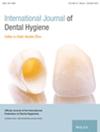Evaluation of the extent of plaque removal and users' experience of alternative toothbrushes: A randomized single-blind crossover study
Abstract
Introduction
In residential care, tooth brushing with a manual toothbrush can be challenging because of technical difficulties, time consumption and poor patient cooperation, resulting in a sub-optimal cleaning. The study aimed at comparing the efficiency in plaque removal, brushing time and users' experience between three toothbrushes: a single-headed conventional manual toothbrush, a triple-headed manual toothbrush and a U-shaped electric toothbrush.
Methods
This was a single-blind crossover study with three pre–post-test conditions. Participants were 26 dental students divided into fixed pairs to play the role of caregivers and care receivers. Pre/post plaque scores were determined by two independent investigators according to the Quigley–Hein Plaque Index (QHI). Questionnaires evaluated participants' experiences. Statistical tests of significances of differences and ANOVA were performed.
Results
Results showed that plaque removal was more effective for the manual toothbrush and the triple-headed toothbrush compared to the U-shaped electric toothbrush (p < 0.001). Brushing time was the longest for the single manual toothbrush (149 s). The U-shaped electric toothbrush showed significantly better results for aspects related to comfort and salivation. The manual and triple-headed toothbrush showed better results for aspects related to cleanliness and motivation to use.
Conclusion
Notwithstanding its favourable comfort, tooth plaque removal is not enhanced by a U-shaped electric toothbrush. The triple-headed and single-headed toothbrushes reduced plaque more substantially than the U-shaped toothbrush. In addition, the triple-headed manual toothbrush was not only effective in plaque removal, but also had a shorter brushing time and was easy to use, being an adequate alternative for care-dependent patient groups.

 求助内容:
求助内容: 应助结果提醒方式:
应助结果提醒方式:


